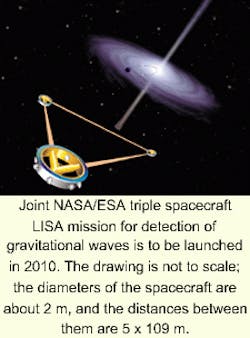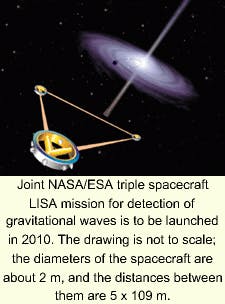ASTRONOMY: LISA to test theory of outer-space vacuum
Hassi Norlén
The question as to whether outer space was empty or filled with an 'Ether' remained unsolved until the late 19th century. In 1887 Michelsen and Morley performed their famous interferometer experiment, effectively establishing the vacuum of space as a reality, once and for all. This theoretical prediction also paved the way for Einstein's deduction that the speed of light is a universal constant. Now a titanic version of the Michelsen/Morley experiment is planned in an attempt to detect de facto waves in what the two scientists had previously deemed void.
"For LISA, we will be using an IR laser because we need a high-power CW laser that can be very frequency stable, and one that is also very efficient in turning electrical power to laser power," explains Dr. William Folkner at JPL (Pasadena, CA), one of the main research facilities working with LISA.
Essentially the laser interferometer space antenna (LISA) will be a giant Michelsen-Morley interferometer in the shape of an equilateral triangle and formed by three spacecraft in orbit around the sun. Each tip of the triangle will consist of one spacecraft each with two separate infrared (IR) laser sources and accompanying mirror and beam-splitting equipment. The interferometer will measure changes in the optical path length along its legs, each some 5 million km long. These changes are due to ripples in the very fabric of space caused by passing gravity waves generated in cataclysmic galactic or extra-galactic events. With a precision of 20 pm, LISA will search for low-frequency gravitational waves that would never be detectable by any terrestrial systems.
The lasers use two monolithic ring Nd:YAG crystals in series, producing 1 W of single-mode output at 1064 nm. The power is reduced from the achievable 2 W in order to extend the lasers' longevity.
According to Folkner, the lifetime of the lasers is one of the hardest design challenges of the mission. "The lifetime needed is at least three years of continuous operation," he said. And this in a project already packed with technical and physical challenges. The key parts of the LISA spacecraft will be the mirrors defining the end points of each leg of the triangle, which define the optical paths of the interferometer. In the LISA case, the mirrors consist of small proof masses, gold-platinum cubes 4 cm on the side. One of the faces of the cube will act as the mirror of the interferometer, as this will be the most stable and unperturbed point of the whole apparatus.
The main problem for LISA is to ensure that the enormous distance between the test masses is changed only by gravitational waves and not by photons or other particles interfering with the mirrors. In effect, the proof masses must be in perfect unperturbed free-fall orbits around the sun, floating in the protective womb of the spacecraft. An electrostatic accelerometer will keep track of where the reference mass is relative to the spacecraft, and a solar-powered ion engine will adjust for any perturbations with a position accuracy of 10 nm.
One laser on one spacecraft will serve as the master and will be locked to an onboard reference cavity. Even an extremely well collimated laser beam will disperse over an arm length of 5 million km, however, which means the beam cannot simply be reflected by a mirror at the far spacecraft. Rather, the incoming beam is phase-locked to the receiving spacecraft's own laser, which is then transponded back to the sending spacecraft. The changes in proof-mass separations are determined by measuring the phase delays for the returning laser beams.
Furthermore, the lasers must be extremely rugged in order to survive the launch and to be able to operate in a vacuumwhere no fans can cool them. There will be no opportunity to repair them after launch. Notes Folkner, "Otherwise the designs are similar to commercial ones, and in fact commercial lasers are currently being re-engineered to meet our requirements, rather than designing a new laser from scratch."
LISA is a joint venture between the European Space Agency and NASA and is slated for launch in 2010 as a medium-scale mission in the NASA Office of Space Science Strategic Plan and as Cornerstone mission 6 at ESA. A LISA technology demonstration flight could fly on the US ST-3 mission as soon as 2004 or 2005.
HASSI NORLÉN is a freelance science writer based in Washington, DC.

